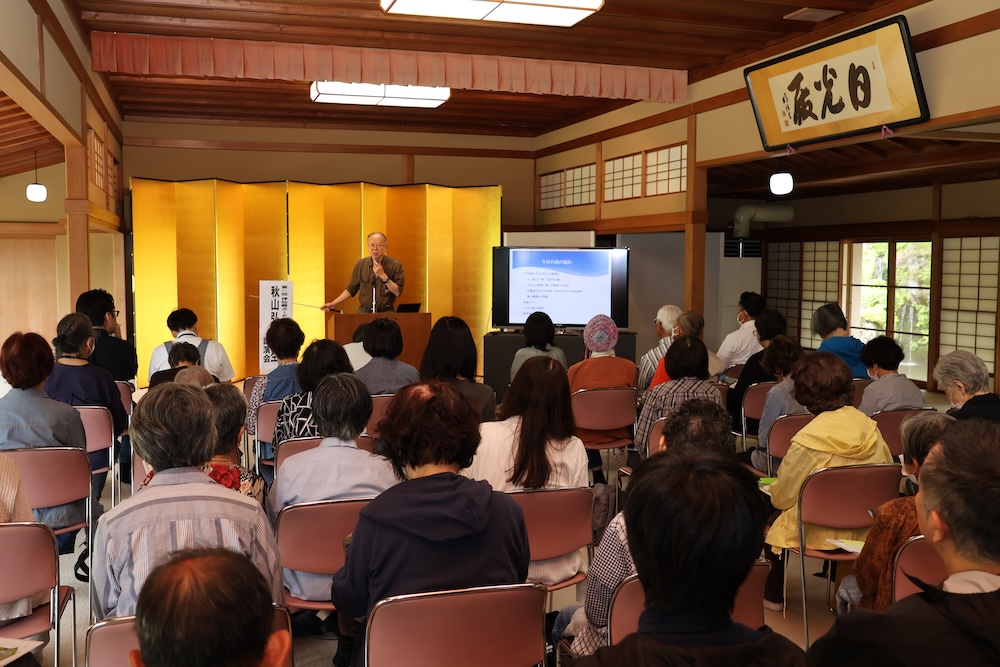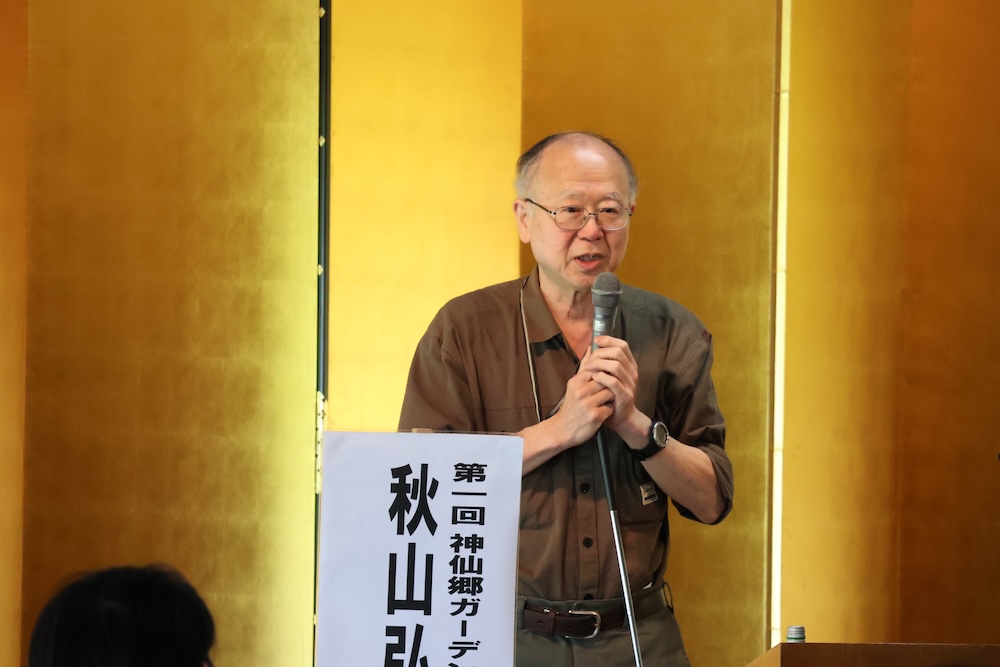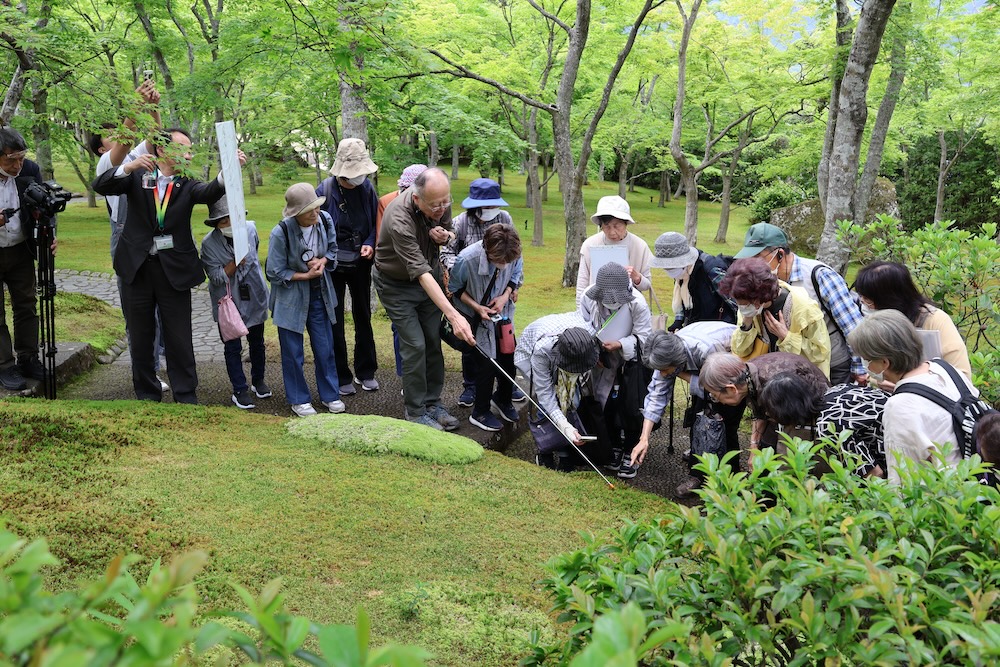Tags:Art and LifeKanto
Hakone Town, Kanagawa Prefecture
Enjoy the beautiful world of moss
On May 25th, the first garden seminar, “Shinsenkyô’s Moss Garden, Beautifully Woven with 125 Types of Moss,” was held at the Sunshine Hall in Shinsenkyô (Hakone Museum of Art), the national Place of Scenic Beauty, in Gora, Hakone-machi, Kanagawa Prefecture. The seminar featured a lecture by moss expert Hiroyuki Akiyama and a moss garden observation session. About 50 enthusiasts from within and outside the Prefecture enjoyed the beautiful world of moss that spreads across the Shinsenkyô Moss Garden. It was an opportunity to reaffirm one of the charms of Shinsenkyô.

The lecturer, Mr. Akiyama, is one of the committee members for the preservation and utilization of Shinsenkyô, the national Place of Scenic Beauty. He is a former researcher at the Hyogo Prefectural Museum of Nature and Humanity, and a moss expert who has been responsible for investigating the moss gardens at Saiho-ji Temple in Kyoto and Hakone Shinsenkyô. A survey conducted in 2021 revealed that there are 125 species of moss (92 species of moss and 33 species of liverwort) growing in the Shinsenkyô Moss Garden.

Mr. Akiyama gave a lecture titled “Various Types of Moss that Color the Shinsenkyô.” He introduced the types of moss, which included moss such as Polytrichum commune, liverworts such as Marchantiales, and hornworts, and then discussed the characteristics of each type of moss. He explained that because they hibernate during the dry days of the day and can quickly absorb the morning dew from the entire surface of their body, they are able to survive in harsh environments where other plants cannot, such as on top of dry rocks or on tree trunks. He said that this is a typical moss way of life, of enduring adversity rather than resisting it.
Touching on the role of mosses, he explained that in the forest, they absorb the power of raindrops, preventing soil erosion and allowing water to seep in at an appropriate rate, and because they have antibacterial properties, they protect other plants from fungi in the soil and help them germinate and take root. He explained that Ezo Sunagoke moss is used for rooftop greening to help curb the heat island effect that causes rising temperatures in urban areas. He emphasized the usefulness of moss by pointing out that while the use of ordinary plants requires soil, which entails costs such as changing structural materials to support the weight and using waterproof sheets, moss is light and requires no maintenance.
This program introduced mosses such as Polytrichum commune, Polytrichum formosum, and Polytrichum formosum, which are commonly found in the moss gardens of the Hojo Garden of Ryoanji Temple in Kyoto, Saihoji Temple, Honen-in Temple, Sanzen-in Temple, and Shinsenkyô, as well as Japan’s three major moss meccasions: Yakushima in Kagoshima, Oirase Gorge in Aomori, and Kita-Yatsugatake in Nagano. He emphasized that “beauty lies in the details,” and asked visitors to observe the beauty of the moss with a magnifying glass that has a magnification of about 10 times.
Afterwards, an observation session was held with the participants at the Shinsenkyô Moss Garden. In addition to observing species such as Polytrichum commune and Polytrichum formosum through a magnifying glass, participants also conducted an experiment in which dormant moss on a rock absorbed water and gradually grew greener, which was well received by the participants.

Many people visited the museum after seeing it on the Hakone Museum of Art website or through flyers, and some were visiting for the first time. Each participant enjoyed the beauty of Shinsenkyô, with comments such as, “It was easy to understand and fun,” “I was amazed at how tenacious the moss is,” “I was shown gardens that are not normally open to the public and was moved by their beauty,” and “I was amazed by the unknown world of moss and was able to discover its beauty. It has changed the way I look at moss. I was moved once again by the splendor of Shinsenkyô.”
The next seminar will be held on July 20th, and will feature a lecture on the theme of “Modern and Contemporary Japanese Gardens and Immortal Villages.” Makoto Honnaka, director of the Nara National Research Institute for Cultural Properties, an independent administrative institution that is a member of the Committee for the Preservation and Utilization of Scenic Places and Immortal Villages and is involved in the protection of Scenic Places and World Heritage sites. Please register to attend the event below.
Date and time: July 20, 2024 (Sat) 10:30~
Place: Place of Scenic Beauty: Shinsenkyô “Sunshine Hall”
Capacity: 150 people
Participation fee: 3,000 yen
Application: Email or postcard
Email address: hakoneart-admin@moaart.or.jp
Postcard address: 1300 Gora, Hakone-machi, Ashigarashimo-gun, Kanagawa Prefecture, 250-0408
“Garden Seminar Office” at the Hakone Museum of Art
*Please include the name, phone number, and address of the person making the application, as well as the names and ages of all participants.
Organized by the Hakone Museum of Art, with the cooperation of Feel the Garden Co., Ltd., the Committee for the Preservation and Utilization of Scenic Places and Immortal Villages, and supported by the Hakone Town Board of Education.






